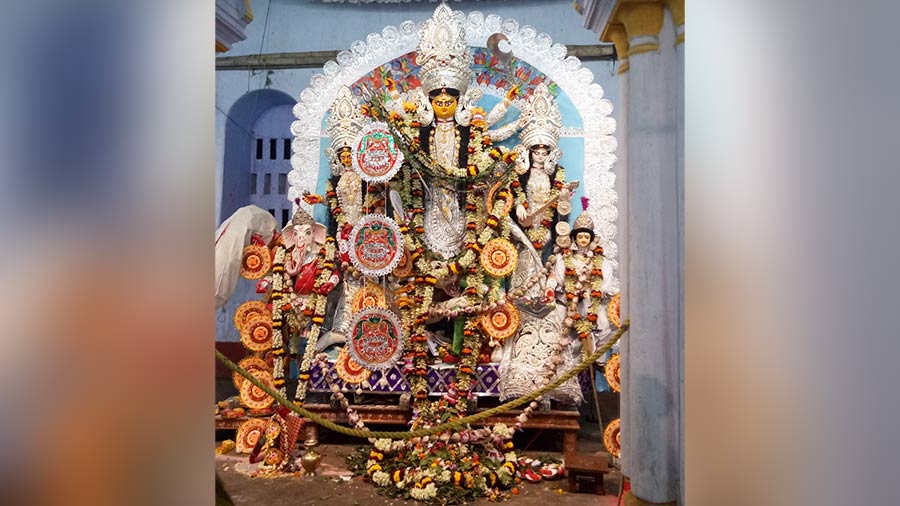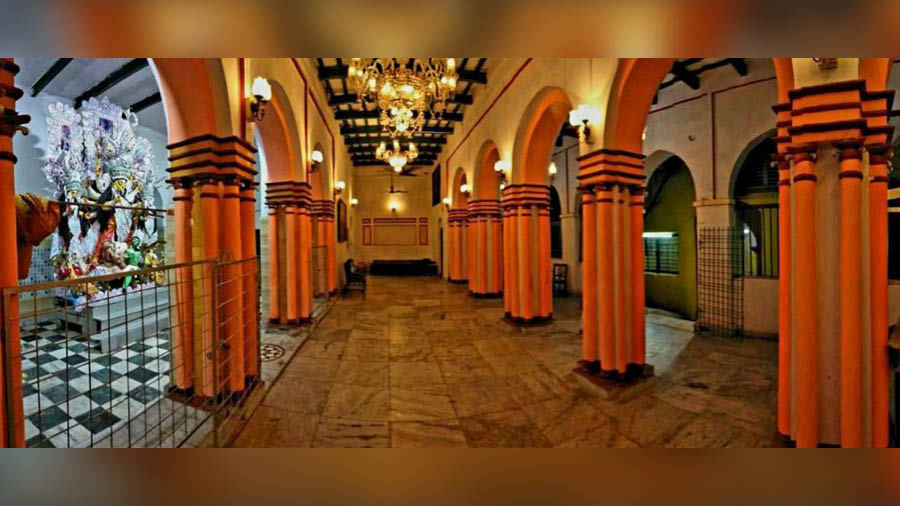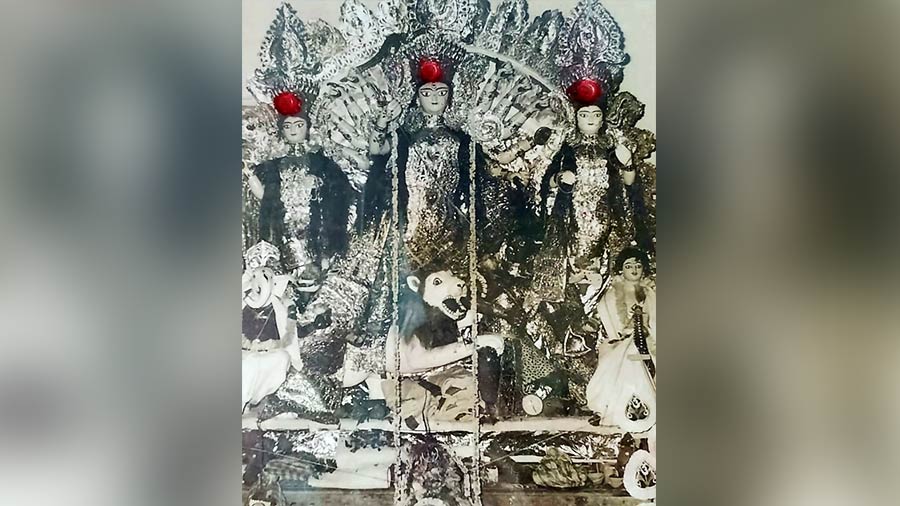A printed nirghanta is distributed among a whopping 780 members of the Serampore Dey family living in various corners of the country and the globe before Durga Puja every year.
An idol decked out in gorgeous daak-er saaj and silver ornaments and exquisite alpona mark the Puja at this house with Corinthian pillars 23km from Kolkata. The house itself is an architectural splendour with double rows of five-columned arches and a huge courtyard and the festival it hosts is as grand as can be.

The deities are dressed up in ‘daaker saaj’ and silver crowns, weapons and accessories Amitabha Gupta
The Dey family’s Durga Puja started way back in 1750. The puja is organised in rotation by four descendants of the family. The person representing each descendant’s family is known as the ‘paladar’.
The family deity, Sridhar Jiu, resides in a small temple above the Durga dalan. The ‘De Paribar Sridhar Jiu Seva Samiti’ comprising family members provide the essential support for organising this family-run puja.

Goddess Durga being put on a silver crown Amitabha Gupta
Ram Chandra Dey came to Serampore from Rishra to obtain land for salt business. After being successful in business, the Dey family bought a considerable amount of land and built the huge mansion with a Durga dalan.
On the day of Rath Yatra, there is the ritual of bansh pujo or khunti pujo, where the size of the bamboo supporting the wooden frame is determined based on the measurement of three-and-a-half size of the forearm of the paladar.
The Durga puja at the Serampore Deys’ is conducted strictly based on Vaishnav rituals. Thus, there is no sacrifice involved in the puja, not even fruits and vegetables.
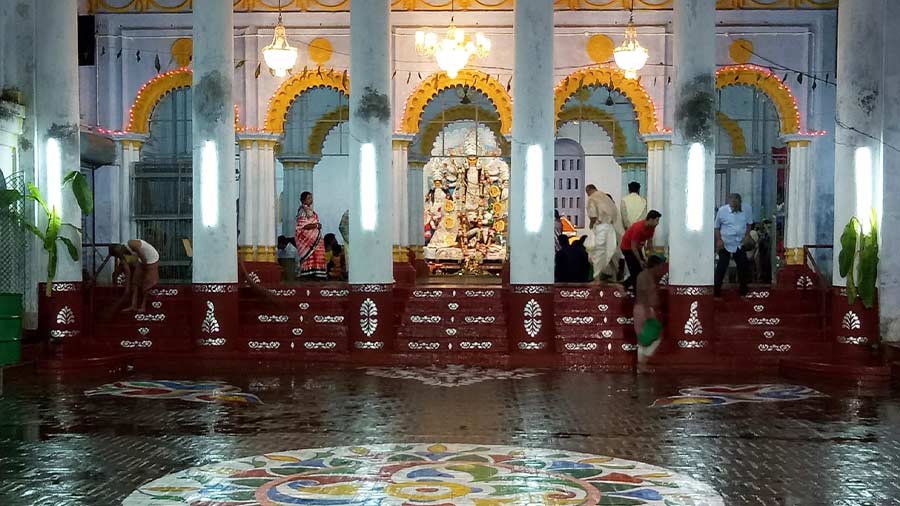
The ‘thakur dalan’ of the family is decorated with ‘alpona’ during Puja Dey family, Serampore
Tarashankar Dey, a senior member of the family said a printed timetable or nirghanta is drawn up and distributed among all members of the family spread all over the country and abroad.
The deity is placed on a wooden jal chowki or a low wooden stool. Married women of the house draw alpona on the chowki on the evening of Tritiya. The deity is placed on this stool on Chaturthi morning and she is dressed up with daaker saaj on Panchami morning. On Sashthi, the deities are adorned with silver crowns, weapons and accessories. The thakur dalan is decorated with alpona too.

Kumari Puja is conducted on Ashtami Dey family, Serampore
The recitation of verses of Chandi starts on Sashthi morning. The ritual of bodhon or awakening of the goddess Durga starts in the late afternoon and married women of the family do the boron rituals in the evening by moving in circumambulatory motion around the goddess.
On Saptami, the nabapatrika is taken a for bath in the Ganga by the descendants of a Brahmin family since ages along with the paladar and others. They return with the ghot or an urn symbolising the goddess filled with holy Ganga water. The De family has three ghots for Durga, Ganesh and the family deity Sridhar Jiu. The family deity is brought down to the Durga dalan, where he presides on a silver throne beside the goddess.
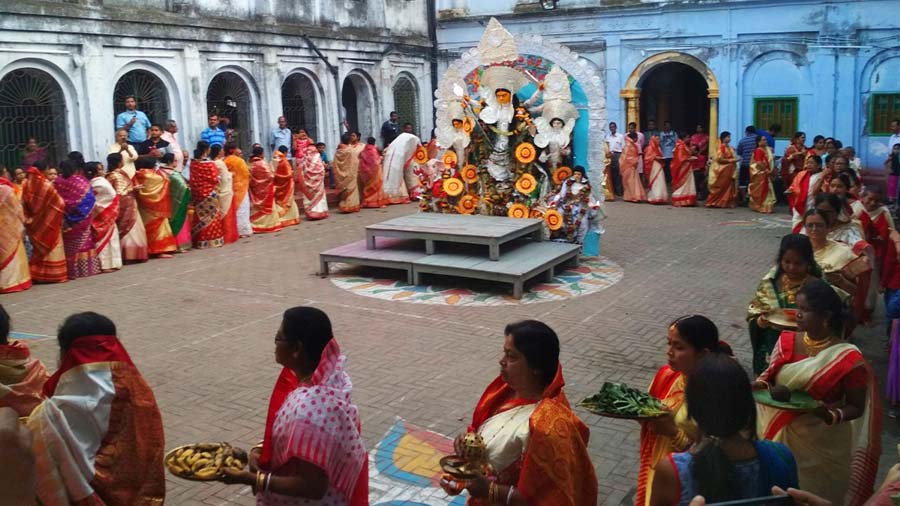
The ‘boron’ rituals comprises a large number of womenfolk Amitabha Gupta
After a bath in the river on Saptami, mahasnan of the nabpatrika takes place in the house. Fifty-one containers with various ingredients like cow dung, cow urine, water washed with gold and silver, turmeric paste, sindoor, various kinds of pulses are mixed with Ganga water. The nabapatrika is washed with this water. Then the ritual of adhibas takes place and the Saptami puja starts.
The bhog or food offered to the goddess is dominated by sweets made of coconut like narkel naru, monohora, narkel bhapa. In the day time, a naibadya of uncooked rice along with fruits accompanied by coconut sweets is offered to the goddess. No cooked food is offered except luchi along with kheer, chhena, nani in the afternoon. On Ashtami, there are two bhogs — one for Ashtami puja and the other for Sandhi puja.

At the Deys’ home, kumari puja takes place on Ashtami. The kumari has to be below eight years and has to be of Brahmin origin. Thereafter, a large number of married women engage in dhuno porano rituals sitting on the huge courtyard.
On Navami, only married couples offer anjali by moving in circumambulation around the deity. This is known as beranjali. First, the representative of the descendant family starts the ritual, followed by the husbands and then the wives wearing traditional attire. Before this anjali, a hom (fire ritual) stretching for a long period takes place. On Dashami, after the darpane bisarjan and other rituals take place, the family deity Sridhar Jiu is taken back to his original residing place. Then the goddess is brought down to the courtyard in the afternoon. The boron rituals start after that, where married women circumambulate the goddess.

Young men and women of the family take part in ‘dhunuchi’ dance Plabon Das
Next, the paladar puts pieces of betel leaves in all 10 hands of the goddess Durga as well as the hands of the other deities, including Mahishasur. The married women involved in boron rituals come one by one with small portions of smashed paan leaves mixed with cardamom and small coconut pieces along with narkel naru and put them in the mouth of the deities as a farewell ritual.
The boron rituals over, young men and women of the family perform dhunuchi dance. Earlier, the male members of the family would carry the goddess to the river on their shoulders but now a trolley is used, where the goddess is placed facing the Dey family mansion.
After immersion, the family members visit the nearby Radhaballabh temple and offer a puja before returning to the family mansion, where everyone visits the Sridhar Jiu temple and the priest sprinkles holy water (shantir jol). The family members then write ‘Shree Shree Durga Sahay’ on bael leaves.
